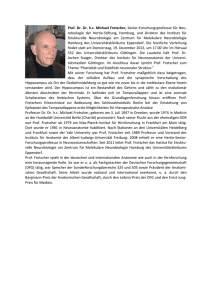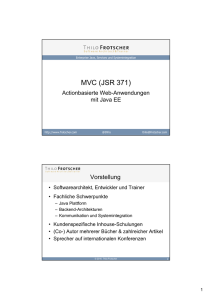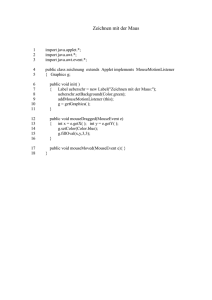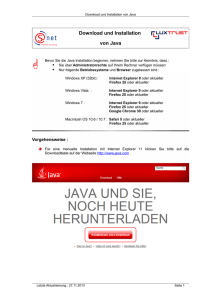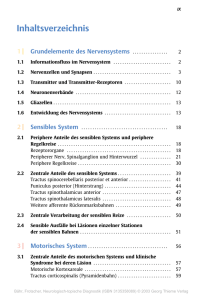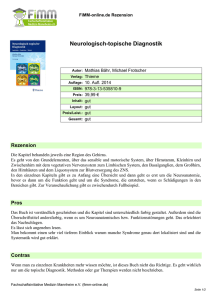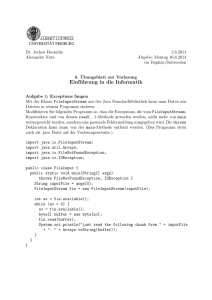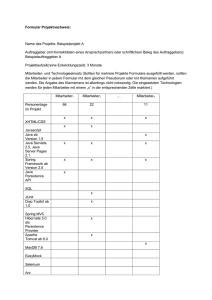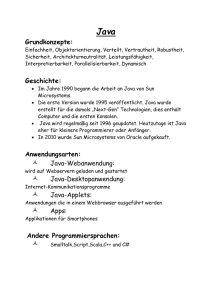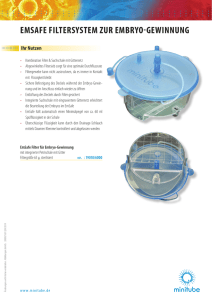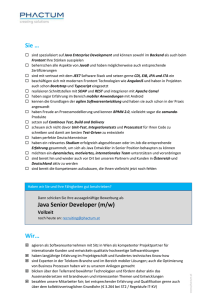JAX-RS 2.0 REST mit Java EE 7
Werbung
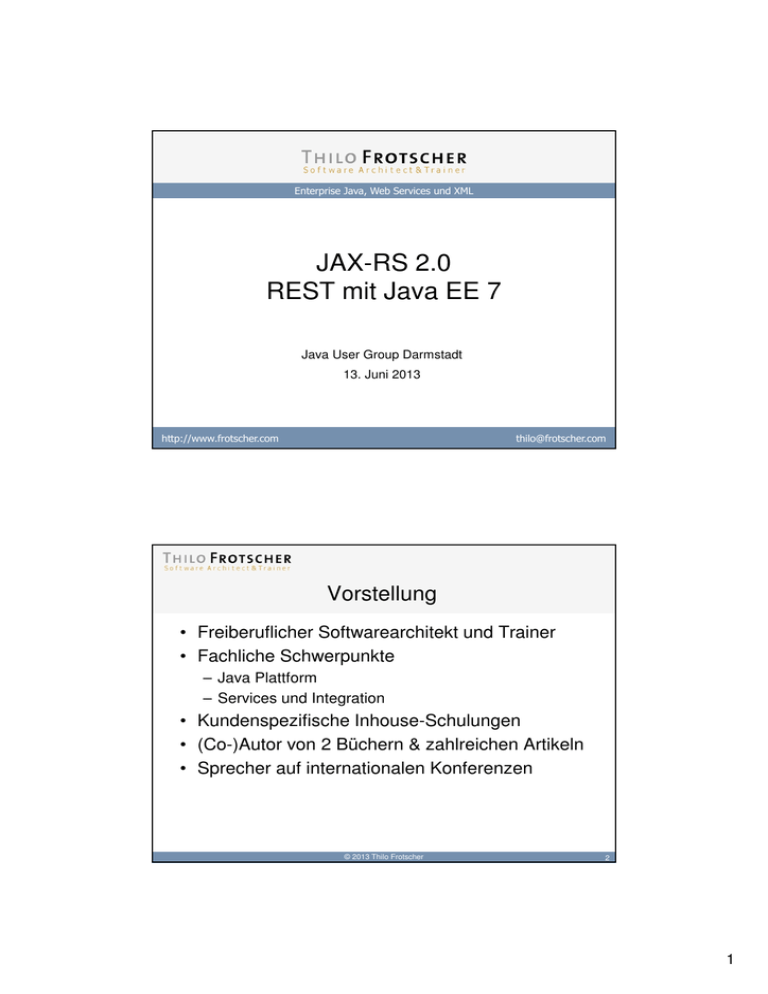
Enterprise Java, Web Services und XML JAX-RS 2.0 REST mit Java EE 7 Java User Group Darmstadt 13. Juni 2013 http://www.frotscher.com [email protected] Vorstellung • Freiberuflicher Softwarearchitekt und Trainer • Fachliche Schwerpunkte – Java Plattform – Services und Integration • Kundenspezifische Inhouse-Schulungen • (Co-)Autor von 2 Büchern & zahlreichen Artikeln • Sprecher auf internationalen Konferenzen © 2013 Thilo Frotscher 2 1 JAX-RS 2.0 (JSR-339) • Referenzimplementierung: Jersey 2.0 – Aktueller Stand: 2.0 Final Release (14.Mai 2013) • Bestandteil von Java EE 7 (JSR-342) – Final Release am 28.05.2013 • Glassfish 4.0: Java EE 7 RI – http://glassfish.java.net/ – Glassfish 4.0.1 in Kürze zu erwarten © 2013 Thilo Frotscher 3 Java EE Roadmap © 2013 Thilo Frotscher 4 2 Neuigkeiten in JAX-RS 2.0 • • • • • • • Client-API Filter Entity Interceptors Support für Asynchronität (Server & Client) Validation Features (Hypermedia) © 2013 Thilo Frotscher 5 Erweiterungen für JAX-RS (1) • Provider – Marshalling und Unmarshalling – Umwandlung von Exceptions in Responses – Bereitstellen von Kontextinformationen für Ressourcen oder für andere Provider • Entity Interceptors – Interceptors für Marshalling / Unmarshalling • Filter – Pre-/Post-Processing auf HTTP-Ebene © 2013 Thilo Frotscher 6 3 Erweiterungen für JAX-RS (2) • Features – Kapselung mehrerer zusammen gehöriger Erweiterungen • Vorsicht, verwirrend! – Provider, Interceptors und Filter werden alle mit @Provider markiert – Alternativ: manuelle Registrierung via API © 2013 Thilo Frotscher 7 Processing Pipeline (Server) © 2013 Thilo Frotscher 8 4 Processing Pipeline (Client) © 2013 Thilo Frotscher 9 Filter • JAX-RS definiert vier Interfaces für Filter • Anordnung in Ketten • Filter können Kette unterbrechen (abortWith) – z.B. fehlgeschlagener Authorisierungsfilter • Sortierung auf Basis von Priorities • Vergleichbar mit Servlet Filter / SOAP Handler • Einsatzgebiete: – Protokoll-spezifische Erweiterungen – Security, Caching, HTTP Method Rewrite etc. © 2013 Thilo Frotscher 10 5 Filter (2) public interface ClientRequestFilter { void filter(ClientRequestContext requestContext) throws IOException; } public interface ClientResponseFilter { void filter(ClientRequestContext requestContext, ClientResponseContext responseContext) throws IOException; } public interface ContainerRequestFilter { void filter(ContainerRequestContext requestContext) throws IOException; } public interface ContainerResponseFilter { void filter(ContainerRequestContext requestContext, ContainerResponseContext responseContext) throws IOException; } © 2013 Thilo Frotscher 11 Entity Interceptors • Filter wirken vor Marshalling/Unmarshalling der Entities im Input/Outstreams – keine Manipulation der Entities möglich • Interceptors kapseln dagegen MBR/MBW – direkter Zugang auf Entity-Streams • Können ebenfalls verkettet werden • JAX-RS definiert 2 Interfaces • Einsatzgebiete: – GZIP, Verschlüsselung, spez. Repräsentationen etc. © 2013 Thilo Frotscher 12 6 Entity Interceptors (2) public interface ReaderInterceptor { Object aroundReadFrom(ReaderInterceptorContext context) throws java.io.IOException, javax.ws.rs.WebApplicationException; } public interface WriterInterceptor { void aroundWriteTo(WriterInterceptorContext context) throws java.io.IOException, javax.ws.rs.WebApplicationException; } © 2013 Thilo Frotscher 13 Asynchronität @Path("/longRunningCalculation") public class MyResource { @GET public void longRunningCalc(@Suspended final AsyncResponse ar) { Executors.newSingleThreadExecutor().submit( new Runnable() { public void run() { ComplexCalcResult calcResult = executeLongRunningCalc(); ar.resume(calcResult); } } ); // Return immediately and handle other requests } } Bsp 1: Ressource mit asynchroner Request-Verarbeitung © 2013 Thilo Frotscher 14 7 Asynchronität (2) @Stateless @Path("/longRunningCalculation") public class MyResource { @GET @Asynchronous public void longRunningCalc(@Suspended final AsyncResponse ar) { ComplexCalcResult calcResult = executeLongRunningCalc (); ar.resume(calcResult); } } Bsp 2: Ressource mit asynchroner Request-Verarbeitung (Session Bean) © 2013 Thilo Frotscher 15 Asynchronität (3) InvocationCallback<List<Order>> callback = new InvocationCallback<List<Order>>() { @Override public void completed(List<Order> orders) { ... } @Override public void failed(Throwable t) {... } }; client.target("http://.../orders/") .request("text/xml") .async() .get(callback); Bsp 3: Nicht-blockierender Request (Client) © 2013 Thilo Frotscher 16 8 Sonstige Neuigkeiten • Features – Kapseln mehrere Erweiterungen • Validation – Integration mit Bean Validation – Constraint Annotations in Ressourcen • Prüfung von Beans und Methodenparametern • Prüfung von Rückgabewerten • Hypermedia – begrenzter Support für Transitional Links (in Headers) – Kein Support für Structural Links © 2013 Thilo Frotscher 17 Zusammenfassung • JAX-RS 2.0 bietet zahlreiche interessante Erweiterungen und Neuigkeiten • Standardisierte Client-API • Filter und Interceptors • Asynchrone Verarbeitung • Validation • Verfügbar separat (Jersey 2.0 in Maven Central) oder mit der Java EE 7-Referenzimplementierung © 2013 Thilo Frotscher 18 9 Thilo Frotscher Kundenspezifisches Training und Beratung zu Java EE, Services und Integration [email protected] © 2013 Thilo Frotscher 19 10
